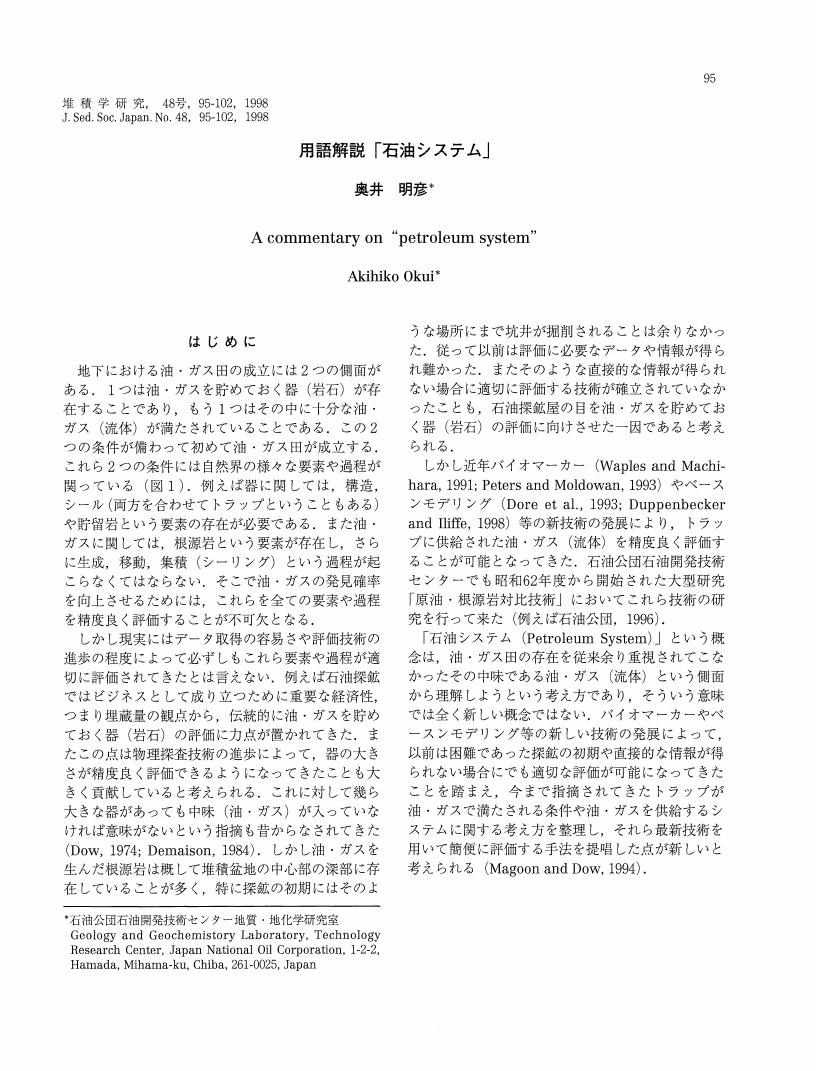1 0 0 0 OA Vein structure
- 著者
- 小川 勇二郎 芦 寿一郎 中島 滋
- 出版者
- The Sedimentological Society of Japan
- 雑誌
- 堆積学研究会報 (ISSN:18844715)
- 巻号頁・発行日
- vol.34, no.34, pp.1-4, 1991-05-01 (Released:2010-05-27)
- 参考文献数
- 11
1 0 0 0 OA 用語解説「石油システム」
- 著者
- 奥井 明彦
- 出版者
- The Sedimentological Society of Japan
- 雑誌
- 堆積学研究 (ISSN:1342310X)
- 巻号頁・発行日
- vol.48, no.48, pp.95-102, 1998-09-30 (Released:2010-05-27)
- 参考文献数
- 21
1 0 0 0 OA 沿岸地域における制約扇状地の性質
- 著者
- 武藤 鉄司
- 出版者
- The Sedimentological Society of Japan
- 雑誌
- 堆積学研究会報 (ISSN:18844715)
- 巻号頁・発行日
- vol.24, no.24, pp.13-18, 1986-04-20 (Released:2010-05-27)
- 参考文献数
- 10
1 0 0 0 OA 北海道白亜系函淵層群の堆積相と堆積シーケンス
- 著者
- 安藤 寿男
- 出版者
- The Sedimentological Society of Japan
- 雑誌
- 堆積学研究会報 (ISSN:18844715)
- 巻号頁・発行日
- vol.38, no.38, pp.45-52, 1993-03-30 (Released:2010-05-27)
- 参考文献数
- 22
The Hakubuchi Group is the uppermost unit of the Yezo Supergroup, a forearc basin sediment distributed along the meridional zone of Hokkaido, Japan. The group in the Sorachi Anticline represents the western marginal facies of the basin, showing conspicuous lateral facies changes. It is subdivided into three formations, Hk1, Hk2 and Hk3, based on the facies distribution. The upward shallowing succession of Hk1 and Hk2 in the eastern limb of the anticline, which is composed of inner shelf to delta plain facies through shoreface, foreshore and beach facies, is interpreted to be a lowstand delta on a conformable sequence boundary. The massive conglomerate facies constituting very thick Hk2 in the western limb and only the uppermost of Hk2 in the eastern limb, may be a transgressive systems tract. The base of the conglomerate in the wester limb corresponds to an erosional sequence boundary. A highstand systems tract is represented by Hk3 distributed widely in both limbs. The upper two parasequences of the three recognized in Hk3 had been partly eroded away under a sequence boundary (clinounconformity) with the Eocene coal measures, Ishikari Group. Therefore, the Hakobuchi Group constitutes a depositional sequence during 10m.y. (Lower Camapanian-Lower Maastrichtian).
- 著者
- 江藤 哲人 松田 恵里 伊藤 憲和
- 出版者
- The Sedimentological Society of Japan
- 雑誌
- 堆積学研究 (ISSN:1342310X)
- 巻号頁・発行日
- vol.53, no.53, pp.17-27, 2001-07-25 (Released:2010-05-27)
- 参考文献数
- 30
- 被引用文献数
- 2
房総半島中部西端部の中部更新統長浜砂礫層および三浦半島中部東端部の上部更新統走水礫層の礫は主に中・古生界に由来する古期岩類で構成され, 次いで中新統の緑色凝灰岩類およびそれに随伴する火成岩類で構成される. そのほか, 第三系堆積岩起源の礫が少量含まれる. 中期~後期更新世の古地理などから判断して, 古期岩類の礫は主として関東山地に, 緑色凝灰岩類および火成岩類は主に丹沢山地にそれぞれ由来すると推定される. 両層堆積期に両山地は大量に礫を供給し得る隆起が起こったと推定できる. 両層の礫種組成には明らかな相違が認められ, 走水礫層の古流向と合わせ考えると, 走水礫層の礫を長浜砂礫層に起源するとみなす見解は否定される. 長浜砂礫層の礫種組成には層位的変化が認められ, 一部の層準に目立つ第三系堆積岩起源の礫は嶺岡山地に由来すると推定され, 嶺岡山地の一時的な隆起を示すと考えられる.
1 0 0 0 OA 堆積環境指標としての炭質物中の黄鉄鉱
- 著者
- 鮎沢 潤
- 出版者
- The Sedimentological Society of Japan
- 雑誌
- 堆積学研究会報 (ISSN:18844715)
- 巻号頁・発行日
- vol.35, no.35, pp.77-81, 1991-11-01 (Released:2010-05-27)
- 参考文献数
- 19
A simple and practical method for estimating salinity is described in this paper based on pyrite (iron disulfide) content in carbonaceous materials by using a reflected microscope. The pyrite content is defined as the proportion of carbonaceous particles which contain pyrite in one hundred carbonaceous particles under microscope.The presence of pyrite in organic sedimentary rocks has been considered to be a result of sulfate from sea water, iron from hinterland, and carbonaceous materials as a reductant in coal swamp.Stratigraphic variations of pyrite content by this method were measured in four areas of Southwest Japan. The pyrite content in three Tertiary areas is in accordance with aquatic environments as previously reported. However, no correlation was observed between pyrtite content and estimated aquatic environments in the Omine coalfield where iron content varies considerably. This method will be employed as a useful tool to investigate sedimentary environments.
1 0 0 0 OA 地質学・土壌学・土質工学における粒径区分の比較
- 著者
- 満塩 大洸
- 出版者
- The Sedimentological Society of Japan
- 雑誌
- 堆積学研究会報 (ISSN:18844715)
- 巻号頁・発行日
- vol.22and23, no.22-23, pp.117-121, 1985-04-01 (Released:2010-05-27)
- 参考文献数
- 6
Comparison of grain size in the fields of geology, pedology, and soil engineering was made on viewpoints of 1) classification and names of each grain size, 2) mechanical grain analysis, and 3) method of each expression of the results of 2).These are quite different system in each field as are shown in Fig. 1. And therefore, much discussions and adjustments among them may be needed, even if each field has each own object.


